“In the year 2044 GlobalCom Venture Capitals, an American corporation, has developed the first interactive resort experience on Mars with the Marsimerica space research institution. Red Planet Respite is the story of the premiere crew sent to test out the luxurious resort intended for the socially elite.”
GlobalCom and Marsimerica are fictional companies, however I thought it would be fun to use this weeks blog to share some of our research on the real life Companies that helped to inspire this play.
1. SpaceX www.spacex.com
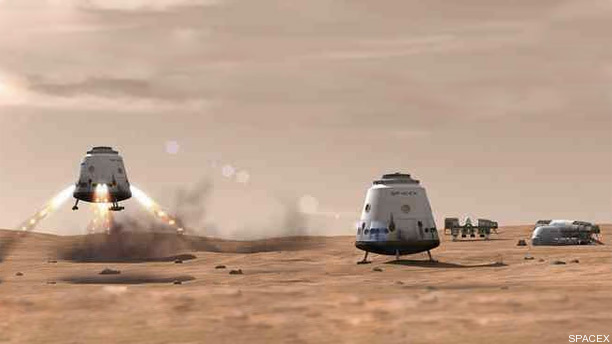
SpaceX was founded in 2002 by Tesla CEO Elon Musk. The company designs, manufactures and launches advanced rockets and space-craft. True to Tesla form, they incorporate sustainability conscious methods into their work such as re-usable rockets and solar power. The CEO and Chief Designer, Elon Musk, served as the main inspiration for Robert Downy’s Tony Stark character in Iron Man. He is young, brilliant, ridiculously wealthy and… kind of a dick. Hey I would be more of a dick too if I knew I was one of the smartest people on the planet. We couldn’t help but be inspired by Musk’s personality either. So we created Dr. Lucian Adams who in the world of our play has revolutionized bionics and even refers to himself as “The Modern Day Iron Man.”

SpaceX predicts that they will be able to land humans on Mars by the year 2022 and plan to transport over 80,000 people in the years that follow for the low low price of $500,000 per passenger. They predict that the total cost of the first mission to Mars will be around $36 billion. That’s less than half of what NASA predicts it would cost to send a manned mission to Mars($100 billion). This initial expenditure would be for all of the set-up needed before tickets can be sold to the general public. This would include some sort of self sustaining food production.
The goals of SpaceX may seem lofty but the innovative company has already gained the respect of NASA and the Space community through a number of mile-stones. “The SpaceX Falcon 1 was the first privately developed liquid-fueled rocket to reach orbit. In 2008, SpaceX won a NASA contract to use its Falcon 9 rocket and Dragon spacecraft to commercially provide the cargo transport function of the space shuttle, which was retired in 2011. In 2010, SpaceX became the first commercial company to successfully recover a spacecraft from Earth orbit with its Dragon spacecraft. And in 2012, SpaceX's Dragon spacecraft became the first commercial vehicle to successfully attach to the International Space Station and return cargo to Earth.”
To get people on Mars, SpaceX plans to adapt their Dragon Spacecraft for human travel. If their past successes are any indication, I have to say I would bet my money on SpaceX to be the first company to land humans on Mars.
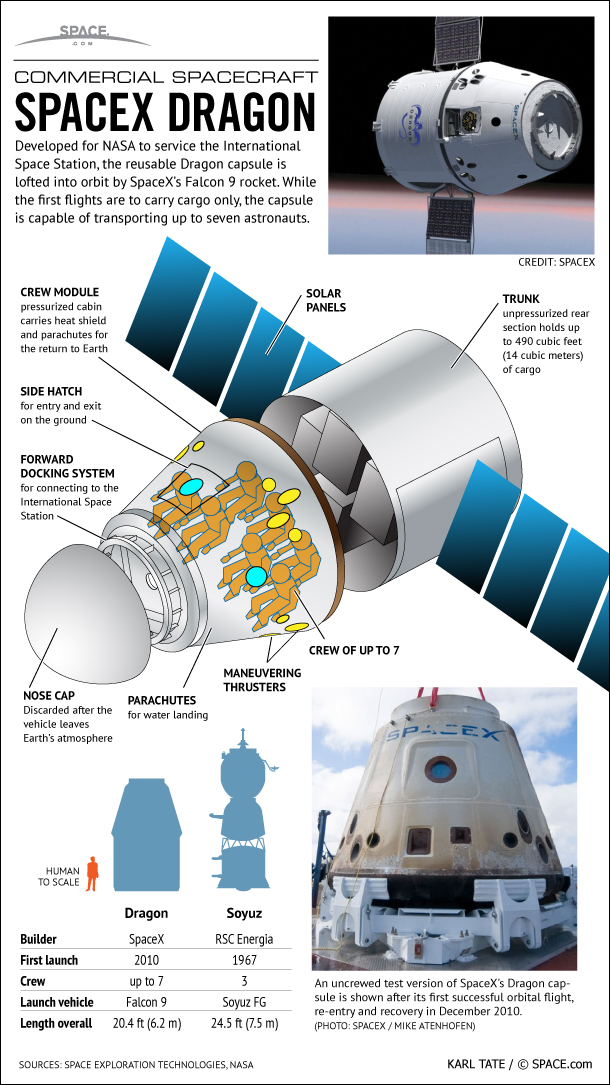
2. Virgin Galactic www.virgingalactic.com
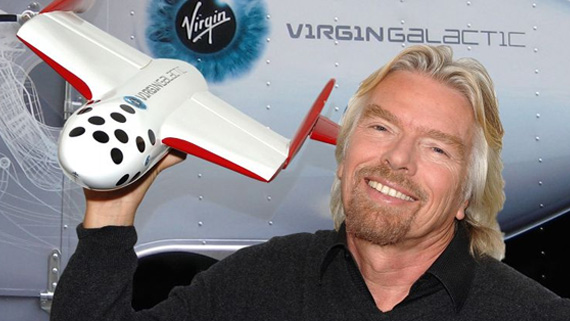
Virgin Galactic was created in 2004 by another inspiring figurehead, Sir Richard Branson, who founded and runs his enormous empire of over 400 companies known as the Virgin Group. Branson and his companies served as the major inspiration for the fictional corporation in our play, GlobalCom, and it’s CEO/Founder Theadore (Teddy) Kinney.
The Virgin Group is best known for it’s Music Label, Airline and Mobile Phone Company but Branson believes there is a healthy market for Space Tourism as well. It appears that he is correct. Virgin Galactic has been accepting deposits from private citizens across the globe and so far over 530 people have paid a portion of the $250,000 per ticket cost to reserve their spot in “the worlds most exclusive club”. Their website is filled with language like that. Their marketing angle is all about social status through space tourism. We borrowed this angle for our own world. We also borrowed Virgins emphasis on safety.
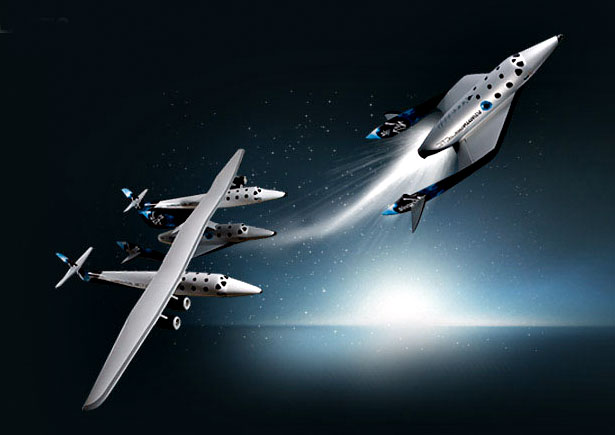
The spacecraft created for Virgin Galactic by Aerospace engineer Burt Rutan is simple, safe and completely different from any spacecraft previously invented. Instead of using a rocket to launch their spacecraft from a vertical ground position that is perpendicular to Earth, VirginGalactic is using a unique looking “mothership” called White Knight to launch its SpaceShip horizontally from 50,000 feet in the air. This method is better, cheaper and safer for many reasons.
“Ground launch comes with intrinsic dangers. The craft has to pass through the lower, denser regions of the atmosphere whilst rocket motor's exhaust is ejected at very high velocity-- Of course, traveling at very high speeds in the lower atmosphere creates a great deal of drag, produces high structural loads and needs a stronger heavier fuselage. Large quantities of fuel are required for the longer duration burn, meaning a bigger-still fuselage, leading to yet more weight, leading in turn to a requirement for more fuel to lift the extra weight, and so on. Effectively detonating a huge bomb at ground level means everything has to go right first time - if it doesn't there are generally few options for those inside.
Burt Rutan calculated that the safest and most efficient strategy was to air-launch his spacecraft from around 50,000ft, a height at which it is already above most of the Earth's atmosphere. This also meant that the rocket motor had to burn only for a very short time in order to reach space and that if there were any problems during the boost phase, the rocket motor could simply be shut down and the spaceship would return as a glider to the runway.”
Virgin Galactic believes it will be ready to fly private passengers into space by the end of this year. Sir Branson and his two children will be the inaugural tour guests and the event will be televised by NBC.
3. Mars One www.mars-one.com
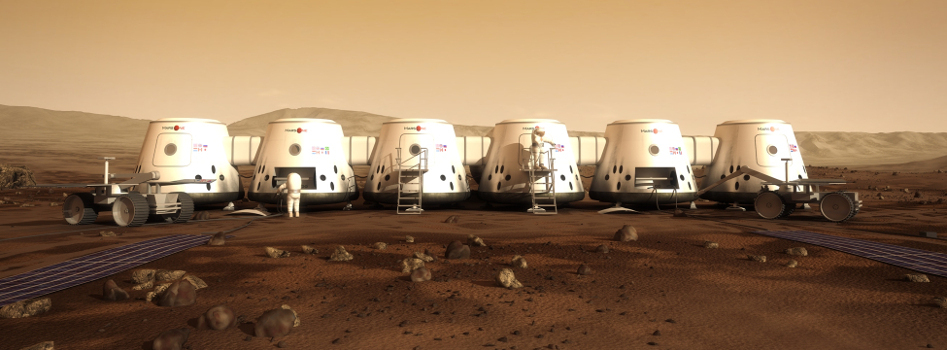
Unlike SpaceX or Virgin Galactic, which are both For-Profit Companies operating out of the United States, designing and building their own machinery; Mars One (founded in 2011) is a Non-Profit Organization, operating out of the Netherlands, that plans to purchase existing technologies from outside suppliers in order to get humans to Mars. And for Mars One Astronauts this is a ONE WAY trip. Their plan is to establish a permanent human settlement on Mars. And they believe the technology needed for this already exists. Now it is just a matter of raising the funds and selecting astronauts.
In April 2013 Mars One announced their search for the future residents of Mars and within months they had over 200,000 applicants. Now they have sifted through the applications and whittled it down to 1,058. The next phase of selection will include rigorous training and testing. Mars One plans to send about 40 pioneers (4 at a time) over the course of several years starting in 2024. However, before any people are sent to Mars, the settlement must be built by 2 rovers that Mars One plans to send to the Red Planet in 2020.

Their plan sounds well thought out but most experts in the world of Space Travel chuckle when Mars One is mentioned. The main reason for this skepticism is that Mars One really hasn’t done anything other than sign up astronauts and raise a small amount of money. Last December they launched an indiegogo campaign with the goal of $400,000 and were able to raise most of it. But this is a small number. Not even enough to score a ride on the SpaceX Mars Mission. And if you check out the list of funders on their website, I’d be surprised if you recognized any of the companies listed. They also don’t list the donation amounts which leads me to believe they are not very big. But Mars One is inspiring and we loved their images and plans for the proposed colony.
4. NASA www.nasa.gov
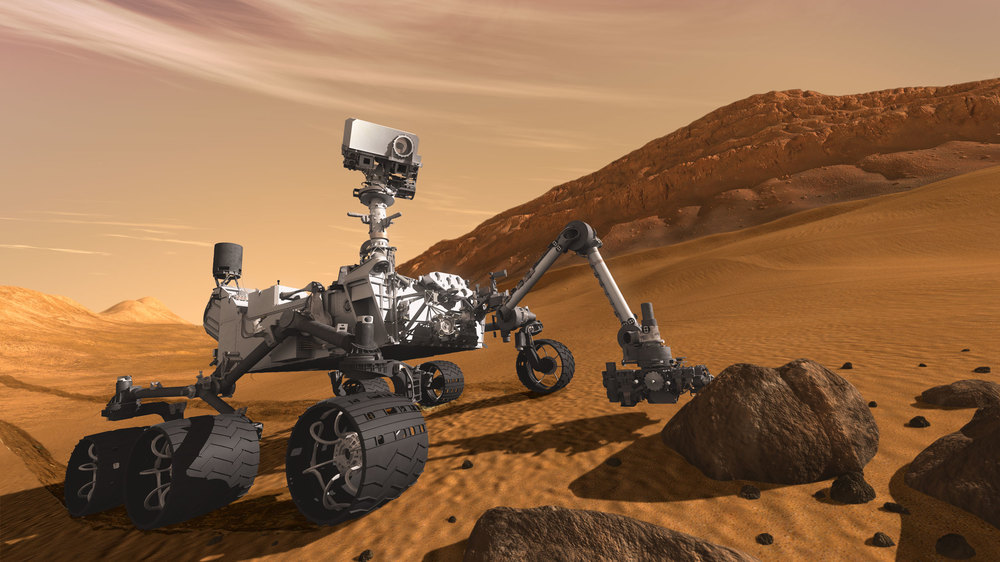
Of course you cant talk about space travel without discussing NASA. So far NASA is the ONLY organization to land anything on Mars. Thanks to Phil Christensen and the Mars Space Flight Facility at Arizona State University WooHoo! (www.mars.asu.edu) NASA and ASU have successfully landed 3 rovers on Mars and orbited 6 satellites around the Red Planet. The hard work and expertise of NASA has been our main source of inspiration and research for our play Red Planet Respite. Unfortunately, NASA has no plans to send any humans to Mars. Due to continuously shrinking funding, they have resolved to reserve all resources for the most scientifically advantageous missions. And since the rovers can do far more advance analysis for a smaller cost and risk, any plans to send humans to Mars have been abandoned.
Another sad fact is that NASA doesn’t currently have the ability to send any humans to space AT ALL. We retired our Space Shuttle fleet in 2011. Since that time, the ONLY way American Astronauts have gotten to the International Space Station is via RUSSIAN space missions. And with all the current tensions between our country and Russia, this is a pretty scary bit of information. It’s a good thing that SpaceX is starting to pick up that slack. Hopefully within the next year they will be able to use Dragon to send American astronauts to the Space Station.
It looks like the USA will reclaim our dominance of space thanks to private enterprise. However, what will be lost when space exploration becomes dominantly commercial? If profit needs to be made, what priorities will change? This is the question we explore in our play Red Planet Respite opening April 18th at ASU's Lyceum Theatre.
